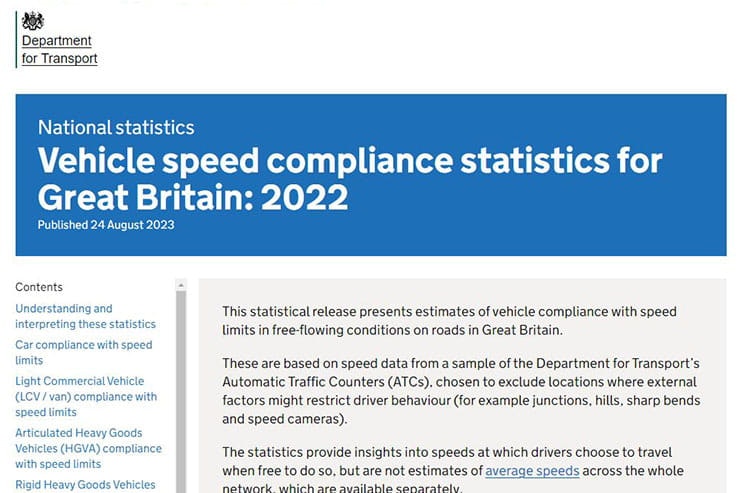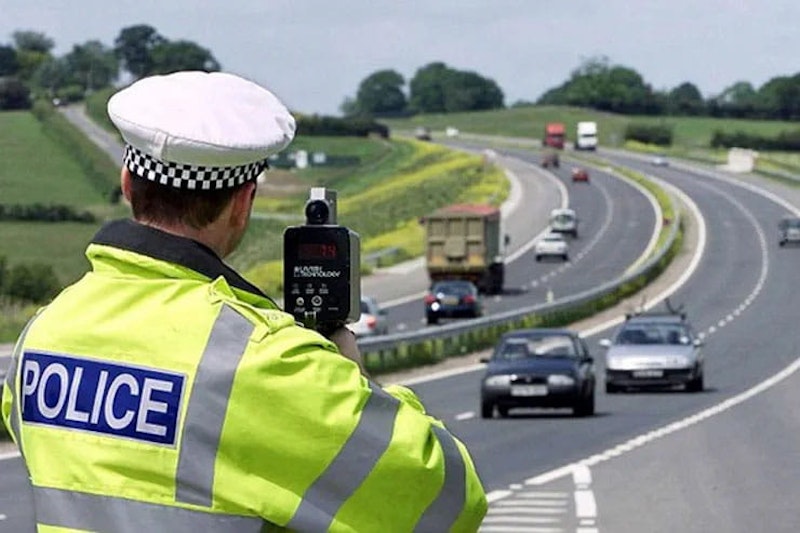Government Stats show majority of bikers exceed speed limits
By Dave Yorke
Freelance journalist
24.08.2023
Click the image above to access the Government report
Whilst the Police and Roads Safety Partnerships are out doing their speed operations, the Department for Transport, DFT, also carry out their own speed analysis to see where and when which road users, including motorcyclists, are speeding.
The figures are published every year and although a year-on-year trend is quite a short span, we can see the figures over a longer period if we need to so how many people do get caught speeding each year.
A sight we all dread, but these stats came from speed monitoring devices rather than police speed-traps
How many people were caught speeding last year?
The figures for 2022 come out between November and December 2023 but in 2021 there were 2,854,757 speed offences detected in 2021 by Police forces along with Road safety Partnerships. That doesn’t include Northern Ireland or Scotland, it’s only for England and Wales and it’s a huge rise from 10 years ago when, according to a report from the RAC foundation, there were 1.8 million speeding offences detected.
How many people did the DFT catch speeding?
The Department for Transport don’t catch people speeding, they monitor the speeds that different vehicle types are travelling at and produce figures as a percentage, they don’t prosecute anyone. The big difference between the DFT and Police are that the DFT monitor the speed at the legal limit, there is no 10% plus 2mph, so a bike travelling at 71mph on a national speed limit dual carriageway is a vehicle travelling over the speed and it’s recorded as such.
To provide a consistent data set, the DFT only monitor speed compliance in free-flowing conditions, that is areas where there aren’t things like speed cameras, sharp bends or junctions which might affect a rider’s judgement.
How many motorcyclists comply with the speed limit?
According to Government Statistics for 2021, in free flow conditions, the proportions of motorcycles complying with the speed limit were 41% on motorways, 72% on NSL single carriageways and 41% on 30mph roads.
That means, on motorways and 30mph roads 59% of motorcycles exceeded the speed limit, compared to 28% on National Speed Limit single carriageways.
For 2022, figures released by the DFT on 24th August revealed that the number of motorcyclists estimated to be exceeding the speed limit on the motorway had dropped to 55%, still over half of all motorcycles but a reduction none the less. It’s the same on 30mph roads where an estimated 56% of motorcyclists exceeded the speed limit where it was 59% last year but motorcycles are the most likely out of any of the road user groups to be speeding in a 30mph limit.
Are motorcycles being ridden at only just over the speed limit?
Again in 2021, the proportion of motorcycles exceeding the speed limit by over 10 mph was 20%, which was higher than car drivers. It’s not just motorways either, 14% of motorcycles in 30mph areas and 10% on NSL single carriageway roads exceeded the speed limit by at least 10mph.
The figures for 2022 also show a decrease in the number of motorcycles travelling more than 10mph over the speed limit on the motorway from 20% last year to only 17% this year.
On 30mph roads it was still a decrease although smaller from 14% last year to 13% this year.
Motorcyclists also tended to speed more at the weekend than during the week and generally from April to September.
Unsurprisingly, weekends, early mornings and evenings (when there is less traffic), and the summer months are the high times for speeding
Do the Police and Road Safety Partnerships only concentrate on speed compliance?
They’ll say they don’t and that they work on a year-round basis where they target the fatal 4 traffic offences of speeding, drink and drug driving, distracted driving and failure to wear a seatbelt although some organisations like to add the further offence of careless driving to make it a fatal 5. Either way, we can only look at the statistics around enforcement to see how much time they spend targeting those other offences to tell us where they are active the most. Drink and drug driving gets a lot of attention, especially around the two main enforcement times of summer and the run up to Christmas and the new year period but as the drivers and riders who commit those offences can’t get an awareness course or a fixed penalty ticket they aren’t included in the figures where 2.8 million road traffic offences were detected which were eligible for an awareness course or a fixed penalty ticket.
You can get a ticket or an awareness course for three of the fatal 4, speeding, distracted driving (read mobile phones for that one) and not wearing a seatbelt so what are the figures like for prosecution of those offence.
It won’t come as a surprise to many, but speeding makes up for 86% of prosecutions leaving 14% for everything else. Some forces are more prolific than others, but the vast majority of detections come from cameras, not actual police officers. However, does that really matter, if you’re speeding and a camera gets you then all that does is release police officers to do work that can’t be automated. There are those that say an actual police officer at the roadside is better, what they really mean is that there’s a chance, a small one maybe, but a chance that they might be let off. With cameras there’s no roadside pleading or mitigation and it’s a course or a ticket or worse.
According to a report from a Parliamentary Advisory Council in 2020, action taken against people not wearing seatbelts had fallen from just under 140,000 in 2011 to just under 60,000 in 2017 even though the study found that 31% of car occupants killed in collisions weren’t wearing a seatbelt. That comes from compliance figures of over 95% for front seat occupants and over 78% of rear seat occupants.
It doesn’t matter where the death comes from, if reduction is the aim surely the police and road safety partnerships should also be targeting the other causes of death on the roads more than they already are.
Do cameras work in reducing road casualty figures?
Lots of studies have shown that cameras do work in reducing the number of Killed and seriously injured people on our roads but, there’s always a but, the parliamentary advisory council report from 2020 found that their effects can be localised. Meaning that the cameras had an effect only where they were situated, and one study found that this reducing effect was evident for up to only 500 metres from the site and that moving further away there was a slight increase in casualties. It still resulted in a net decrease though.
Do speed awareness courses work in reducing reoffending?
To find out whether there was a positive outcome involved in completing a course, Ipsos MORI carried out an analysis for the Government in 2018. Two groups of road users were looked at, those who were eligible for a course and had declined the opportunity and those who were eligible and had completed one. Considering several variables such as the number of years a driver had held a valid licence, prior motoring convictions, offence type, vehicle speed, distance to nearest course location, price offered at the nearest course location and live points on licence the results showed that the driver taking a speed awareness course was 23% less likely to be caught speeding again than a driver who hadn’t taken a course. That figure is only valid for up to six months after the course and it diminishes as time goes on, reducing to 7% after three years. After three years though, we’re eligible for another course, and repeat.
Are speeding fines too lenient?
A Fixed Penalty Notice for speeding is £100, plus the inevitable 3 points, a speed awareness costs broadly similar. That’s less than the penalty for using a mobile phone, another of the fatal 4 offences, which is currently £200 or 6 points and if you live in London its less than the cost of straying into a bus lane, stopping in a box junction or even parking in the wrong place which all cost more than £100.
With 2.8 million speeding offences being detected each year it does suggest that an awful lot of people either don’t think they’ll be caught or that £100 doesn’t matter to them or that there is a safety net to avoid points on a licence at the expense of a speed awareness course. It might suggest that a lot of people think the speed limit is wrong or inappropriate and at the same time it also suggests that the authorities do give people who are at the lower end of the speeding scale a chance to not do it again without getting points on a licence.
If you’d like to chat about this article or anything else biking related, join us and thousands of other riders at the Bennetts BikeSocial Facebook page.
Share on social media:

